I hope this works! Within this article is also interesting information on Errol.
Biography of Theodore Thomson Flynn
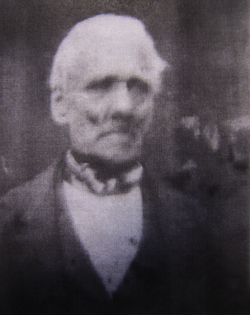 |
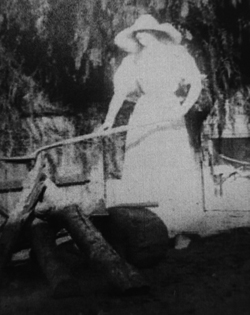 |
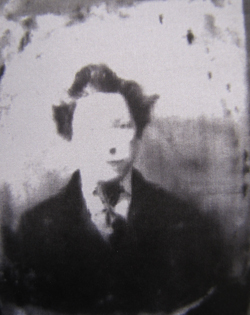 |
| Unnamed lantern slides from Theodore Thomson Flynn's personal collection, thought to be T.T.’s father John Thompson Flynn, his mother Jessie and himself as a child, but this has not been confirmed. |
||
Theodore Thomson Flynn was born in Coraki, New South
Wales on 11 October 1883, son of John Thompson Flynn and his wife
Jessie, née Thomson. Educated in Sydney, he received his BSc from the
University of Sydney in 1909, and taught high school science before
being appointed to the Newcastle and Maitland Technical Colleges as a
lecturer in chemistry and physics. His appointment to the lectureship in
Tasmania began what became an eminent career in biology.
Flynn’s wife Lily (later called Marelle) accompanied him
to Tasmania, and their son Errol
was born at the Queen Alexandra Hospital, Hobart, on 20th June 1909.
Errol attended several schools in Hobart, and reportedly trapped
bettongs for T.T. Flynn’s research into the reproductive biology of
marsupials.
In 1910, the university received a substantial donation
from the estate of John Ralston, a wealthy pastoralist from St Leonards,
who left £8,000 to further scientific research. These funds, the first
major bequest to the institution, were directed towards support of the
new discipline of biology. The majority of the funds went to endow a
chair, and the remainder were spent on a biology laboratory and the
purchase of equipment. Flynn became the Ralston Professor of Biology and
inaugural chair of the fledgling department in 1911.
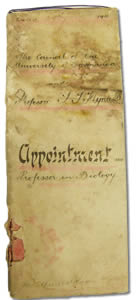 |
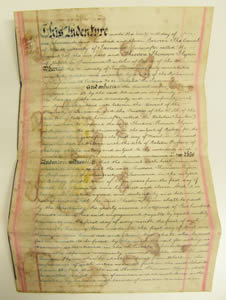 |
| Indenture of T.T. Flynn’s appointment as Professor of Biology at the University of Tasmania on the 29th June 1911 |
|
Under the original terms of the agreement, Flynn was to
carry out research into
1. “diseases of plants and animals
2. anatomy and development of marsupials unique to
Tasmania
3. any other research approved by the trustees”.
In 1921, a new agreement with the Ralston Trustees added a
4th category of approved research:
4. research on commercial food fisheries in Tasmania.
Photographs of the University of Tasmania around
the time of T.T.Flynn's employment:
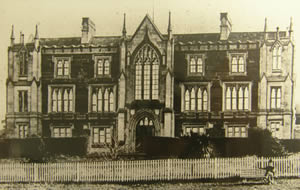 |
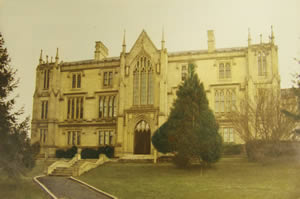 |
| University of Tasmania, 1907 |
University of Tasmania – Domain site |
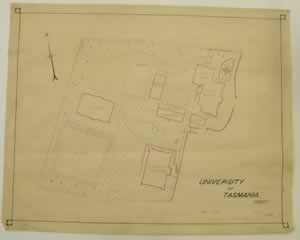 |
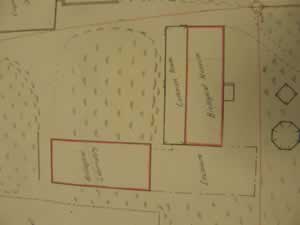 |
| Plan of the University of Tasmania – 1928 enlarge |
|
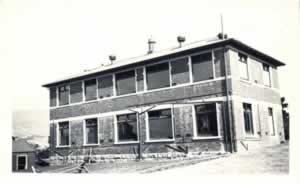 |
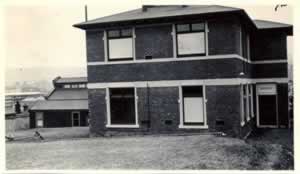 |
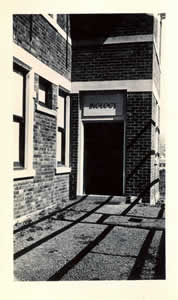 |
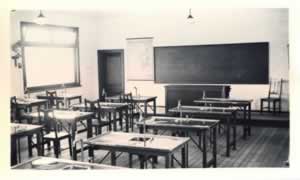 |
| Top: Photos of the original Biology building, the lower storey was built in 1909, the upper storey in 1936, Bottom: the entrance and the Zoology (left) and the Botany laboratory (Right) (V.V. Hickman photographs) |
|
|
|
|
Tasmanian Field
Naturalists Club
‘Soon after his arrival in Tasmania in 1909 Flynn had joined
the Field Naturalists Club. ..In 1909 Flynn had participated in the
Easter excursion to Freycinet Peninsula, where he led the discussion on
invertebrates. In November he addressed the monthly meeting on the
subject of flounder. This is an early indication of his interest in
marine biology and fisheries. He told members that there was plenty of
scope for dredging in the Derwent Estuary to collect specimens for
study. In 1910 Flynn led the Club Easter excursion to Wineglass Bay. The
steamer Koonookarra was used during these Easter camps for dredging
marine life under his leadership. Field Naturalists, under his direction
carried out some of the first scientific dredging along Tasmania’s
coastline.His ten year involvement with the Field Naturalists culminated
in his election as Chairman in 1918, and again the following year’
As well as the Field Naturalists Flynn developed
other important links with the wider Tasmanian scientific community
outside the University. He was first elected to the Council of the Royal
Society in 1911 …[and] through [this] position became a Trustee of the
Tasmanian Museum and Botanical Gardens in 1911. Flynn took on the work
of curator and was active in supporting its functions and adding to the
collection.’
|
Tasmanian Field
|
|
(Right) Tasmanian |
|
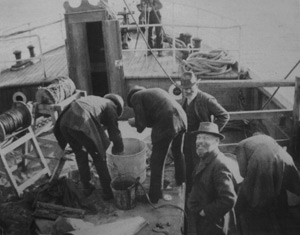 |
(left) ‘Field Naturalists, under the direction of Professor TT Flynn of the University of Tasmania, carried out some of the first scientific dredging along Tasmania’s coastline. The only man who can be identified is the photographer Beattie, a member of the Club who took many photographs of their activities.’ The Companion to Tasmanian History – online version. |
|
(Right) Tasmanian Field Naturalists |
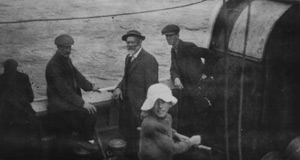 |
Thylacine skull (Thylacinus cynocephalus)
Flynn held the post of honorary curator of the Tasmanian
Museum from 1912-1918. The Museum has in its collection a complete
thylacine skeleton collected by T.T Flynn in 1919. He was one of the
first advocates for the protection of the thylacine. In 1914 he
suggested that some should be captured and placed on an island, a
strategy being considered today as a means of protecting the Tasmanian
devil. (S. Jones – School of Zoology)
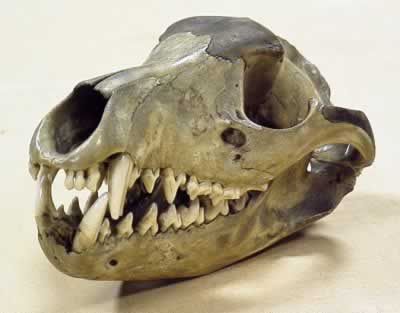 Thylacine skull collected by T.T Flynn in 1919 Tasmanian Museum and Art Gallery collection. |
Birth of the Kangaroo
by T. T. Flynn, 1928
‘Flynn became famous for his work on the embryology of marsupials and
echidnas. He became determined to educate the public that kangaroos were
not born on the nipple and went so far as to publish a Workers
Educational Association (then a forerunner of Adult Education) booklet
on the Birth of the
Kangaroo. I fear that it was not too widely read because around
1950 the locals in Ouse still adhered to the incorrect view.’ (E.
Guiler – School of Zoology)
Bettong (Bettongia gaimardi)
‘Professor T.T. Flynn published a paper on the
reproduction of the Tasmanian bettong that summarized much of his work
over the previous 10-15 year period in 1930. His infamous son the
film-star Errol Flynn, often assisted his father in capturing bettongs.
‘When school finished, I raced home to be at his side, to
hurry out into the back yard, where we had cages of specimens of rare
animals…Through Father’s activity I made my first venture into commerce.
He bought all the kangaroo rats [bettongs] he could get hold of for
Hobart University. I learned to set box traps in the hills of near-by
Mount Wellington. He paid a shilling a head.’ (Errol Flynn, My
Wicked, Wicked Ways). No further scientific work was carried out
(on the Bettong) for the nearly 50 years or so until I started my
studies in the late 1970s.’ (Randy Rose, School of Zoology)
Tasmanian Devil (Sarcophilus harrisii)
Flynn’s first paper on the anatomy of the Tasmanian
devil was written in 1910 from a specimen given to him by Colonel JEC
Lord. In the introduction to the paper he indicated that he had
intended to delay publication until he could dissect a number of
specimens but had found that the species was already so scarce that
further specimens could not be obtained. In these circumstances Mrs.
Roberts’ Beaumaris Zoo in Battery Point was a most valuable facility. In
1910 she had been asked by the Director of the Sydney Zoo to try and
obtain specimens of the devil and the thylacine for the London
Zoological Society. This prompted her to begin holding these animals in
her zoo and to try to breed the devil in captivity’.
‘Flynn was particularly interested in discovering all he
could about Tasmanian marsupials, as he feared for their survival. After
he left Tasmania the devil population grew quickly but while he was at
the University they were quite scarce’.
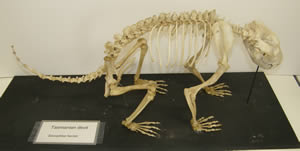 Tasmanian Devil skeleton (Sarcophilus harrisii) |
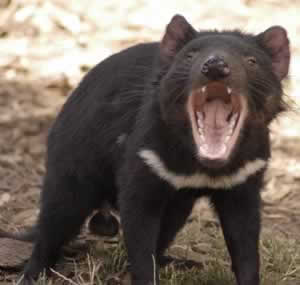 Tasmanian Devil (Sarcophilus harrisii) |
Specimens and scientific papers
Flynn is considered to be one of the pioneers of research
into the reproductive biology of marsupials and monotremes. He published
an important work on the early cleavage of the monotreme egg, and was
awarded a DSc in 1921 for his work on the embryology of marsupials. His
interest in the placental structure of blue-tongued lizards is echoed
today by the School of Zoology’s strong research focus on the ecology
and evolution of viviparous lizards.
In addition, he published an eclectic series of papers on
the fauna of Tasmania, including sea spiders (Pycnogonida) and
a freshwater sponge. Flynn also described a fossil whale from Fossil
Bluff on the north coast of Tasmania. The
fossil Prosqualodon davidis is c.23 million years
old, and is held in the collection of the School of Earth Sciences,
UTAS.
Flynn’s classic paper on the yolk sac and allantoic placenta in the
barred bandicoot which appeared in the prestigious Quarterly Journal
of Microscopical Science in 1923 was awarded the University Medal
when presented to the University of Sydney as a thesis for the degree of
Doctor of Science.
|
|
 Henry Crouch brass binocular microscope (c.1890) and microscope slides prepared by T.T. Flynn from the School of Zoology. |
|
|
|
|
|
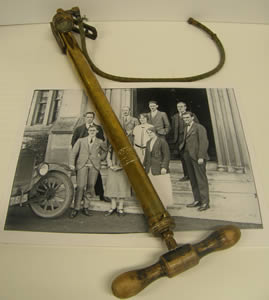 The brass car pump belonged to the Departmental car shown in this photo. (Pump now held in the School of Zoology) |
| University staff group photo 1924 University staff, 1924; (l. to r., top) Dr. A.L. McAulay, H.P. Tuck, C. Malthus, Prof. J.B. Brigden, J.A. Johnson, Prof. Burn, Prof. D. Copland,; (centre) A.R. Hewer, P.L. Griffiths, Lt-Col. Thomas (Registrar), E.A. Counsel, C.C. Dudley, G.S. King, L. Rodway; (bottom) Prof. R. Dunbabin, Prof. Williams, W.J.T. Stops (Vice-Chancellor), Sir Elliott Lewis (Chancellor), Prof. McDougall, Prof. T.T. Flynn, Prof. Lucas |
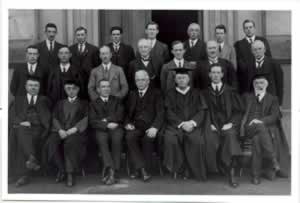 |
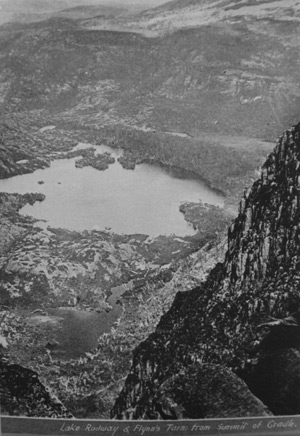 |
(left) Flynn Tarn Photograph by Fred Smithies of Lake Rodway and Flynn’s Tarn (named after Professor Flynn and Leonard Rodway, two of the most important biologist of their time) from the summit of Cradle Mountain. (Archives Office of Tasmania) |
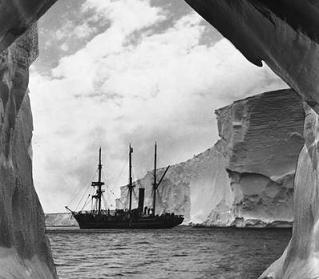 S.Y.Aurora |
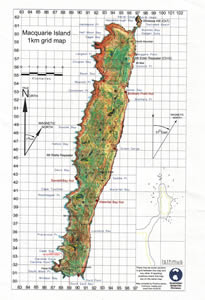 Flynn Lake, Macquarie Island, named after T. T. Flynn – enlarge map |
Aurora Expedition to Macquarie Island
In May 1910 at a meeting of the Royal Society Flynn
seconded the motion to set up a committee to promote Sir Douglas
Mawson’s Antarctic expedition. He and Mawson had been at school and
University together in Sydney. In November 1912, Flynn joined Mawson’s
Australian Antarctic Expedition as the biologist in charge for the
second summer research cruise on the S. Y. Aurora.
The decision to accept the leadership of this program was
somewhat rash. His experience in marine research was limited and
confined to the inshore waters off the east coast of Tasmania and
Sydney. He could not have been prepared for the tumultuous seas between
Macquarie Island and Tasmania in a vessel not built or crewed for the
task, but having found his sea legs he began the dredging program.
In June 1913 he addressed the Royal Society on the results
of the five weeks of dredging and illustrated it with lantern slides.
Flynn’s Antarctic connection is commemorated in the name of Flynn
Lake on the west coast of Macquarie Island.
He developed a considerable interest in marine science,
and became a strong advocate for science-based development of fisheries
in Tasmania and at the national level. He undertook a review of the
Tasmanian fishing industry, and proposed some priority scientific
projects, including comprehensive studies of the biology of the oyster
and the crayfish, to underpin effective fisheries management.
In 1931, the Ralston Trustees cut their funding to
support only a lectureship. Flynn left the university to take up a chair
at the Queen’s University, Dublin, where he continued scientific
research for anther ten years before retiring in 1948, that event being
noted in the prestigious scientific journal Nature, Vol 162,
July 24th 1948.
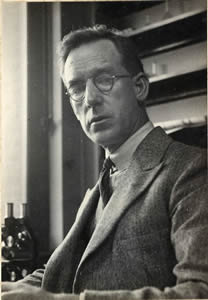 T.T. Flynn, Queen's University Dublin |
| T.T. Flynn and his wife Marelle taking friends from St Albans to visit Errol’s film set. |
Detail: T.T. Flynn and his wife Marelle |
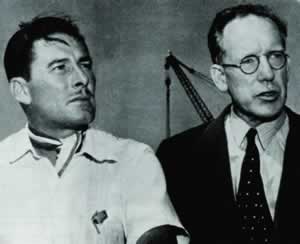 Errol Flynn and T.T.Flynn |
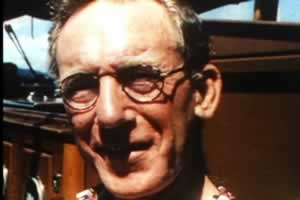 T.T. Flynn on Errol's yacht 'The Zaca', 1952 |
Impressions of T. T. Flynn
‘T.T. was full of pranks and at one staff dance he produced a small
marsupial out of his pocket much to the consternation of all. Something
must have gone wrong with the joke when he appeared with a black eye’
(Eric Guiler – School of Zoology)
‘Flynn established a research reputation for zoology in
Tasmania and the Department has always flourished in this field. He was a
flamboyant teacher in a time when the University had several such. He
stands tall among his successors being a stronger character than most of
them. In some respects he was careless of administration but in those
days the running of the University was largely left to the Heads.’ (Eric
Guiler)
‘The rapport was with my father. He looked Irish. He had
red, bushy eyebrows, black hair; he was lean, angular, full of charm,
good will, and a certain professorial quietness. He spoke with a clipped
British accent, tinged with touches of Irish brogue.’ (Errol Flynn,
My Wicked, Wicked Ways)
‘Vernon (VV) Hickman, who succeeded Flynn in 1932, was a
student in the early years and remembers Flynn as an excellent teacher
who took a great interest in his students: at least those who showed an
interest in the subject.’ (Anthony Harrison, ‘Climbing to the top:
T.T. Flynn in Tasmania, 1909-1931’ )
‘Theo Flynn was tall, slim, broad shouldered and
blue-eyed; softly spoken, charming and witty. He was very industrious
but also gregarious and friendly, enjoying dancing and tennis, as well
as his academic interests’…Guiler knew him as a ‘very powerful
personality full of drive and energy that led him into many adventures,
credible or otherwise’.(E. Guiler, Sunday Tasmanian, 8 July
1990).
Transcription & letter (pictured below) about
T. T. Flynn to Professor Eric Guiler from Louis Bisdee, July 1990
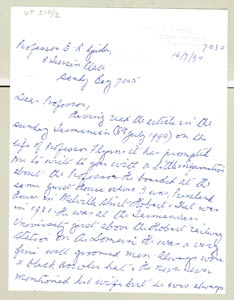 |
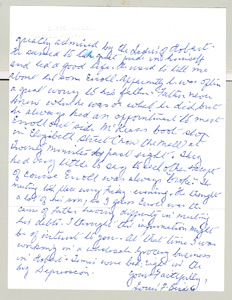 |
Kelvin Grove,
Melton Mowbray,
Tasmania 7030.
16/7/90
Dear Professor,
Having read the article in the Sunday Tasmanian
(8th July 1990) on the life of Professor Flynn it has prompted me to
write to you with a little information about the Professor. He boarded
at the same guest house where I was, Pressland House in Melville Street,
Hobart. That was in 19?1. He was at the Tasmanian University just above
the Hobart Railway Station on the Domain. He was a very fine well
groomed man. Always wore a black bowler hat. He never ever mentioned his
wife but he was always greatly admired by the ladies of Hobart. He
seemed to take great pride in himself and led a good life. He used to
tell me about his son Erroll. Apparently he was often a great worry to
his father. Father never knew where he was or what he did but he always
had an appointment to meet outside McKeans boot shop in Elizabeth Street
(now the Mall) at twenty minutes past eight. They had very little to
say to each other except of course Erroll was always ‘broke’. The
meeting took place every Friday evening. He thought a lot of his son, so
I guess Erroll was the cause of father having difficulty in meeting his
debts. I thought this information might be of interest to you. At the
time I was working in a wholesale grocery business in Hobart. Times were
bad: right in the big Depression.
Yours faithfully,
Louis F. Bisdee
|
Pressland House |
The Geology Department’s
acquisition of the remains of Prosqualodon davidis Flynn
Prosqualodon davidis was described in 1923 by
Prof. Flynn who was Professor of Zoology at the University of Tasmania.
When originally found in Miocene sediments at Fossil Bluff, it was
virtually complete. After description, it was held in the Zoology
Department collections in the old part of the Sandy Bay campus, near the
sports oval. It was one of the best-preserved squalodont whales
known. There is some confusion about the name (davidi or davidis)
but I believe the latter is correct.
In approximately 1966, I was visiting Dr John Hickman of
the Zoology Department and passing through a roofed, but otherwise open,
space when I noticed what appeared to be bone from Fossil Bluff. I was
told that the fragments were the remains of the specimen studied by
Flynn. I was horrified by both the condition of the specimen and lack
of care. The bone was breaking up under the influence of varying
temperature and humidity. Pyrite oxidation probably was the cause. I
came back to the Geology Department, reported to Prof. Carey, and we
quickly arranged for the remains to be brought here and placed in our
vault where better (if not perfect) care could be taken of the
specimen.
When brought over, we found that most of the original
specimen did not exist and we were told that much of it probably had
been taken to the rubbish tip at some stage. More horror! Dr John
Cosgriff, a vertebrate palaeontologist, was here at the time and took
some steps to improve the condition of what was retrieved but the
remains are a sorry remnant of the original. The Tasmanian Museum and
Art Gallery has an excellent cast of the skull and that is worthy of
study.
[Notes by Patrick G. Quilty AM, Honorary Research Professor,
17 June 2004].
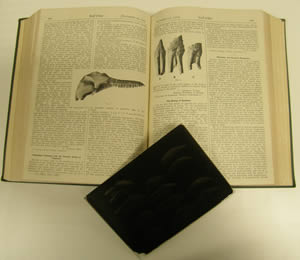 Flynn, T.T., 'Squalodont Remains from the Tertiary Strata of Tasmania' from Nature, November 25th, 1929 |
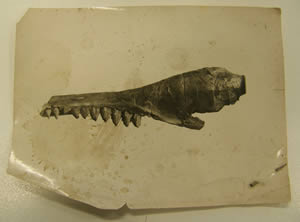 T.T. Flynn' s photograph of jawbone of fossil whale Prosqualodon davidis |
Whale fossil specimen
Prosqualodon is a whale, not a dolphin. It is
referred to as a primitive toothed whale probably with lifestyle and
body shape very similar to a modern dolphin – an example of convergent
evolution. It is a squalodont with triangular, sharklike serrated teeth
and thus unlike modern dolphins although modern dolphins probably
evolved from this group. [Patrick G. Quilty].
— Tina
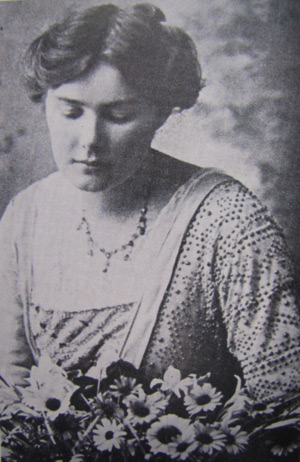
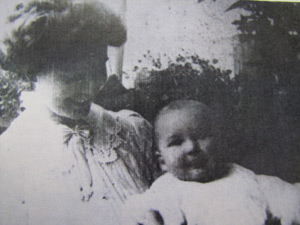
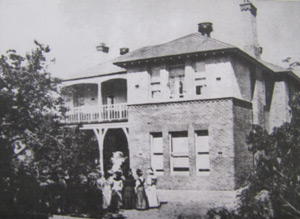
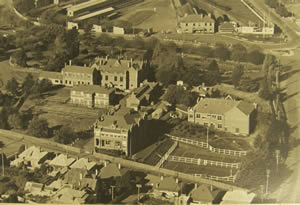
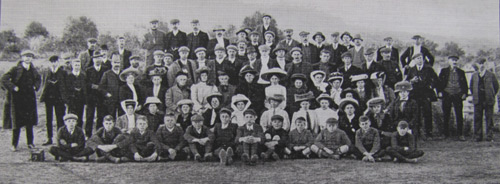
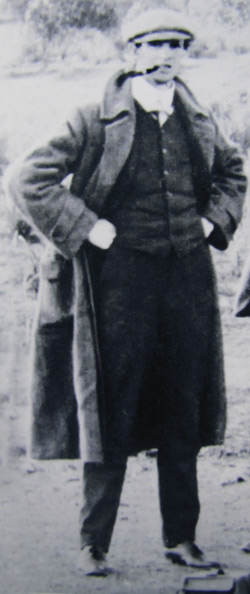
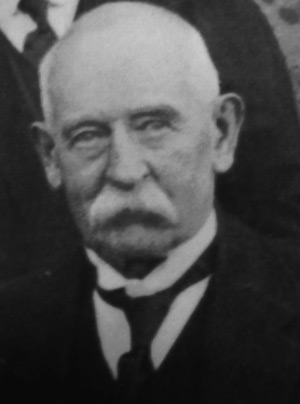
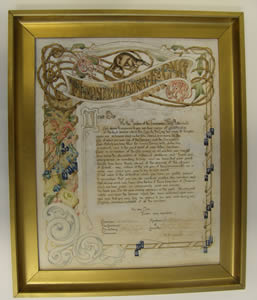
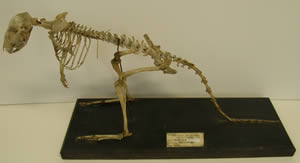
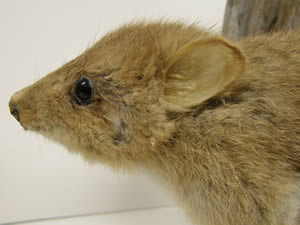
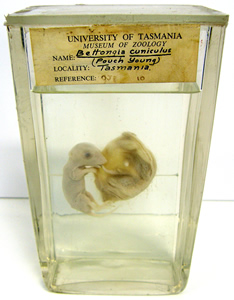
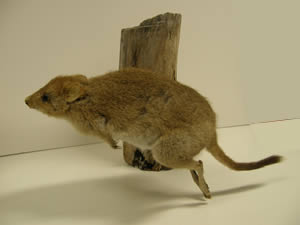
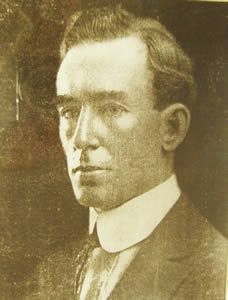


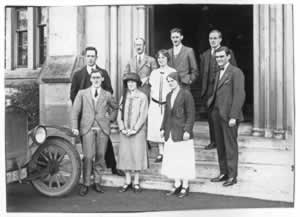
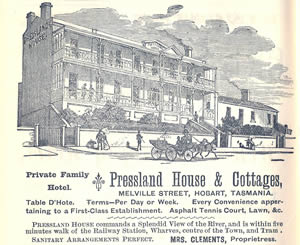

Wow, Tina, what an enormous amount of work! You must have gone through hundreds of sources to piece this together! Great job!
No – No – No!
I used to have the habit – a long time ago – when I found something interesting I copied and paste it into a word document and that is one of it. I learned better since. I tried several times to get it on the blog but it wouldn't take it, it would either disappear or it would display an error message when I wanted to publish it. David tried to help me too – thanks David – but just one of those things.
Finally it worked – here it is now! Maybe some of our members will enjoy it too like you do!
This is an extraordinary posting! Fascinating material, Tina! We know that father and son had a sometimes rough time the bond between them was very deep. You can see it in the way Errol has been photographed just looking at his father, and he did often writer to his father throughout his life.
Thank you David!
I have a few more of these articles in my word documents which we maybe could put under one tab – maybe “Prof. T.T. Flynn”? Maybe you have a good idea!
What about a “family” tab? Oh, there is one already I see. Wouldn't it go there perfectly?
Hi Inga;
David obliged already and as you see he made a sub-tab under “Friends & Family” and I will transfer my post and post others there too.
Funny enough there are always nice and interesting remarks about Errol contained in his biographies or write-ups.
For example like this one:
“Prof. T.T. Flynn – Fisheries Commissionaire”
The election of the Labor Government drew Flynn into public life. One of the many community functions to aid the War effort was the Carnival Queen competition run by the Lord Mayor of Hobart. Enid Lyons, the new wife of the Premier, was one of the entrants and accompanied by six year old Errol Flynn.
Interesting isn't it – I wonder if there is a picture of this event? Six year old Errol in the limelight with no less than just the Prime Ministers new wife!
It is surprising what tidbits about Errol one can find in his father's biographies!
True, Tina! Who knows in which archives there might be a copy of this event…
I don't think so Inga!
If there exists a photo of this Carnival event with Errol on the float – wow – now that would be really something!
And btw Enid Lyons was no slouch!
Dame Enid Muriel Lyons, AD, GBE (9 July 1897 – 2 September 1981) was an Australian politician and the first woman to be elected to the Australian House of Representatives as well as the first woman appointed to the federal Cabinet. Prior to these achievements, she was best known as the wife of the Premier of Tasmania and later Prime Minister of Australia, Joseph Lyons.
Have you searched every photo archive Down Under, Tina dear?
Dear Inga, I have done so much over the years I can't even remember what – just about everything – and on top of it I stored the info badly I didn't know any better then. I'll sort it out one day!
Good idea, Tina! But it will be hard!
Hopefully! Take care!
Hi David;
Thanks for making the tab so fast! The sub-tab under Friends and Family is a perfect fit and I will transfer it.
While we are on the subject of tabs, do you think you could make a main tab in a slide show format (not a sub-tab) titled “Errol Flynn's Homes” or “Errol's Homes” what ever suits better? I have some good information I could post.
Take care,
Tina
Tina, there has been an Errol Flynn's Homes tab under Photos for some time already that has not been posted to, apparently! Either that, or somebody added it! To view a photo album as a slide show you can click an icon at the top of the album page that looks like a pair of slides…
I found it – thanks David!
I remember me asking you for this tab as I have good information for it, but I never could find it. I really think it is very hidden under photos. I don't want to be a nuisance but it it possible to put it out on the main page? I have a feeling that these sub pages don't get much traffic – anyway – just if you can. Thanks
Hi David;
Thank you very much for moving the tab to the main page! I hop you like my entries?
Take care!
Fantastic what a brilliant job, thanks for posting this.
Thank you Lesley!
There is a lot of interesting information out there and what is most interesting is that it was never published in the ordinary sense sort of hidden information – like the one with the Carnival. Just visualize little 6 year old Errol on the carnival float with the Premier's wife.
Take care, always good to hear from you!
Now, if only someone could do this for all of Errol's life!
Robert, do what for Errol's life??? Copy every website that exists about him?
No, write a pictorial life story.
… [ ;-)]
Robert, what would be the best program to use for such undertaking to incorporate pictures and text? If the program is good it shouldn't be much of a problem to put it together, except time consuming as everything one does of this nature.
I really wouldn't know.
I know someone who is doing that RATHER BRILLIANTLY, too!
Makes me damn jealous.
Not only that but if you walk into your bathroom you will find him standing in front of the mirror!
Like the infamous Count of Transylvania, I have no mirrors in my house.
You'll have to hold up a candle and then look at the shadows on the walls! I tell you, he is there!
Who David? Would be great to know as Robert has a great idea to make a life pictorial of Errol!
I am teasing Robert! I am referring to HIM!
Nosferatu? How about that–a bloodsucker memorializing a muckraker!
LMAO, you two funny guys!
Yes, our very own Robert who is doing a terrific job!
Nosferatu will be honored to hear that, Patti
Great job Tina.
Thanks Nick and Mary Ann!
great job putting this together, Tina. This is very interesting to know about Prof. Flynn.